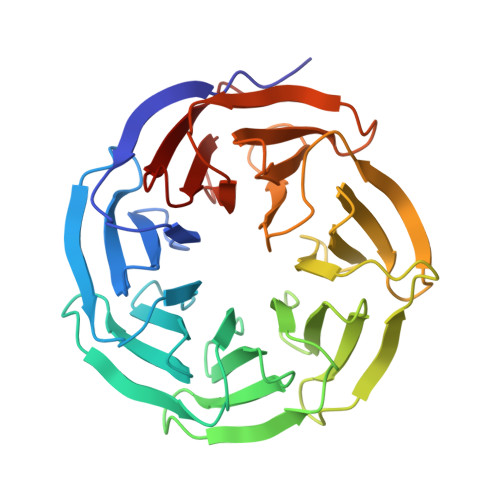Discovery and Optimization of Salicylic Acid-Derived Sulfonamide Inhibitors of the WD Repeat-Containing Protein 5-MYC Protein-Protein Interaction.
Macdonald, J.D., Chacon Simon, S., Han, C., Wang, F., Shaw, J.G., Howes, J.E., Sai, J., Yuh, J.P., Camper, D., Alicie, B.M., Alvarado, J., Nikhar, S., Payne, W., Aho, E.R., Bauer, J.A., Zhao, B., Phan, J., Thomas, L.R., Rossanese, O.W., Tansey, W.P., Waterson, A.G., Stauffer, S.R., Fesik, S.W.(2019) J Med Chem 62: 11232-11259
- PubMed: 31724864
- DOI: https://doi.org/10.1021/acs.jmedchem.9b01411
- Primary Citation of Related Structures:
6U5M, 6U5Y, 6U6W, 6U80, 6U8B, 6U8L, 6U8O - PubMed Abstract:
The treatment of tumors driven by overexpression or amplification of MYC oncogenes remains a significant challenge in drug discovery. Here, we present a new strategy toward the inhibition of MYC via the disruption of the protein-protein interaction between MYC and its chromatin cofactor WD Repeat-Containing Protein 5. Blocking the association of these proteins is hypothesized to disrupt the localization of MYC to chromatin, thus disrupting the ability of MYC to sustain tumorigenesis. Utilizing a high-throughput screening campaign and subsequent structure-guided design, we identify small-molecule inhibitors of this interaction with potent in vitro binding affinity and report structurally related negative controls that can be used to study the effect of this disruption. Our work suggests that disruption of this protein-protein interaction may provide a path toward an effective approach for the treatment of multiple tumors and anticipate that the molecules disclosed can be used as starting points for future efforts toward compounds with improved drug-like properties.
Organizational Affiliation:
Department of Chemistry , Vanderbilt University , Nashville , Tennessee 37232 , United States.















